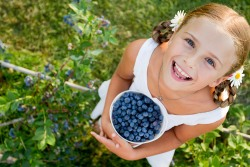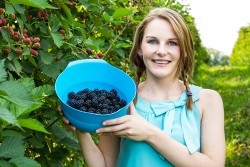Growing berries in South Africa has become popular as fruiting plants are more readily available, and are the easiest addition to growing your own food collection. Plant the larger varieties along a fence or trellis where they can also be used as a hedge or screen.
 As small shrubs, goji berries are often limited in size depending on the container they grow in, and are larger when grown in a garden bed.
As small shrubs, goji berries are often limited in size depending on the container they grow in, and are larger when grown in a garden bed.Growing the best berries is easier than one thinks. They are perfect for teaching children about food gardening, and if you don’t grow them for the fruit basket, you can grow them to attract birds to the garden. From new trendy goji berries to tough, old favourites like blackberries, Eckards shares advice to inspire you to add some to your garden.
Some practical tips
Most berries produce more fruit as they establish and mature. In South Africa most are deciduous or semi-deciduous, and fruit through late summer and autumn.
Mulch them regularly with a layer of compost and feed them every second month with Sudden Impact for flowers to stimulate growth and flowering.
Tip: Organic fertiliser will result in stronger plants that bear fruit with stronger flavour.
Goji berries
Until a few years ago, few people had heard of goji berries. The goji trend started when health shops began adding them in muesli and cereal bars, promoting them as a super fruit. They are full of Vitamin C, other vitamins and more.
 Cranberries grow as a flat spreading plant, much like strawberries, and need a constant water supply.
Cranberries grow as a flat spreading plant, much like strawberries, and need a constant water supply.The fresher the berries, the better they are for you, hence the trend to now grow your own. But, they must be harvested when fully ripe; only then are they edible.
As small shrubs, goji berries are often limited in size depending on the container they grow in, and are larger when grown in a garden bed. Fruiting end of summer, these deciduous plants lose their leaves through winter.
They are ‘hungry plants’ and need to be fed regularly to grow well. Add a routine feeding of Seagro between feeding the Sudden Impact. As they mature, prune them in winter to keep their shape and to produce more fruit.
Cranberries
Cranberries grow as a flat spreading plant, much like strawberries, and they need a constant water supply. Grow them in a container or in the garden where they can get daily water. Mulch them with a layer of compost every year followed by a layer of river sand to keep them moist. The sand also keeps down weeds and helps them to root new plants along the stems.
 Blueberries are among the easiest fruits to grow organically and they produce abundant fruit.
Blueberries are among the easiest fruits to grow organically and they produce abundant fruit.They prefer a slightly acid soil. Feed them with an acid plant food which will help change the pH of the soil ideally.
Cranberries grow for many years and there are reports of plants in America that are over 100 years old. Fruit are harvested right at the end of autumn just before the frost season starts in winter. By encouraging bees in your garden, you will find more fruit on your cranberries.
Blueberries
Blueberries are among the easiest fruits to grow organically and they produce abundant fruit. You can grow a blueberry bush almost anywhere. Boost your immune system naturally by eating them ripe and fresh.
They prefer a slightly more acid soil and can also be grown in containers to limit their size. They are low maintenance and if left unchecked could easily end up as an impenetrable hedge, which could be a good security feature if planted up against a boundary wall. Watch out for thorns on the stems if you are growing them for children to harvest.
 Blackberries need full sun. They aren't fussy about the soil, although good drainage is important and soil rich in compost is best.
Blackberries need full sun. They aren't fussy about the soil, although good drainage is important and soil rich in compost is best.Tolerant of heat, blueberries are also hardy against our local cold winters. Plant them in a full sun spot with well-drained soil and liberal composting to get them established.
Blackberries
A single blackberry plant will produce an abundance of fruit. Blackberries are not only delicious, they are also an excellent source of anthocyanins. These are plant pigments, which are antioxidants stimulating the immune system and are known to help prevent heart disease and cancer.
Like most other bramble fruits, blackberries bear best on old wood, which are stems in their second or third year. If you cut them back heavily in spring, the growth is fresh and considered as new wood, limiting your fruit supply. Pretty pink flowers in early summer are followed by the fruit, which is ready to be harvested through late summer into autumn.
Blackberries need full sun. They aren't fussy about the soil, although good drainage is important and soil rich in compost is best. The plants are relatively drought tolerant, but they'll need a steady supply of water to get them established.
Article courtesy of www.eckards.co.za.







